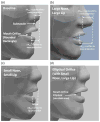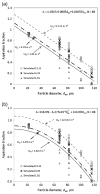Contribution of facial feature dimensions and velocity parameters on particle inhalability
- PMID: 20457783
- PMCID: PMC4780249
- DOI: 10.1093/annhyg/meq040
Contribution of facial feature dimensions and velocity parameters on particle inhalability
Abstract
To examine whether the actual dimensions of human facial features are important to the development of a low-velocity inhalable particulate mass sampling criterion, this study evaluated the effect of facial feature dimensions (nose and lips) on estimates of aspiration efficiency of inhalable particles using computational fluid dynamics modeling over a range of indoor air and breathing velocities. Fluid flow and particle transport around four humanoid forms with different facial feature dimensions were simulated. All forms were facing the wind (0.2, 0.4 m s(-1)), and breathing was simulated with constant inhalation (1.81, 4.3, 12.11 m s(-1)). The fluid flow field was solved using standard k-epsilon turbulence equations, and laminar particle trajectories were used to determine critical areas defining inhaled particles. The critical areas were then used to compute the aspiration efficiency of the mouth-breathing humanoid. One-tailed t-tests indicated that models with larger nose and lip features resulted in significantly lower aspiration efficiencies than geometries with smaller features, but the shape of the orifice into the mouth (rounded rectangle versus elliptical) had no effect on aspiration efficiency. While statistically significant, the magnitudes of differences were small: on average, the large nose reduced aspiration efficiency by 6.5% and the large lips reduced aspiration efficiency by 3.2%. In comparison, a change in breathing velocity from at-rest to heavy increased aspiration efficiency by an average of 21% over all particle sizes, indicating a much greater impact of aspiration efficiency on breathing rate in the facing-the-wind orientation. Linear regression models confirmed that particle diameter and breathing velocity were significant predictors to the aspiration fraction, while the facial feature dimensions were not significant contributors to a unifying model. While these effects may be less pronounced as the orientation changes from facing-the-wind, their impact confirms the importance of breathing velocity and, to a lesser extent, facial feature dimensions on exposure estimates in low freestream velocities typical of occupational environments.
Figures




Similar articles
-
An empirical model of human aspiration in low-velocity air using CFD investigations.J Occup Environ Hyg. 2015;12(4):245-55. doi: 10.1080/15459624.2014.970273. J Occup Environ Hyg. 2015. PMID: 25438035 Free PMC article.
-
Computational fluid dynamics investigation of human aspiration in low-velocity air: orientation effects on mouth-breathing simulations.Ann Occup Hyg. 2013 Jul;57(6):740-57. doi: 10.1093/annhyg/mes108. Epub 2013 Jan 12. Ann Occup Hyg. 2013. PMID: 23316076 Free PMC article.
-
Computational fluid dynamics investigation of human aspiration in low velocity air: orientation effects on nose-breathing simulations.Ann Occup Hyg. 2014 Jun;58(5):625-45. doi: 10.1093/annhyg/meu018. Epub 2014 Mar 24. Ann Occup Hyg. 2014. PMID: 24665111 Free PMC article.
-
Perspectives on aerosol inhalability: concepts and applications.Crit Rev Toxicol. 2025 Feb;55(2):227-247. doi: 10.1080/10408444.2025.2458276. Epub 2025 Feb 27. Crit Rev Toxicol. 2025. PMID: 40013986 Review.
-
A review of inhalability fraction models: discussion and recommendations.Inhal Toxicol. 2010 Feb;22(2):151-9. doi: 10.3109/08958370903025973. Inhal Toxicol. 2010. PMID: 19552521 Review.
Cited by
-
Impact of nasal septal perforation on the airflow and air-conditioning characteristics of the nasal cavity.Sci Rep. 2024 Jan 29;14(1):2337. doi: 10.1038/s41598-024-52755-4. Sci Rep. 2024. PMID: 38281976 Free PMC article.
-
An empirical model of human aspiration in low-velocity air using CFD investigations.J Occup Environ Hyg. 2015;12(4):245-55. doi: 10.1080/15459624.2014.970273. J Occup Environ Hyg. 2015. PMID: 25438035 Free PMC article.
-
Variability in coefficient of restitution in human facial skin.Skin Res Technol. 2014 Aug;20(3):355-62. doi: 10.1111/srt.12126. Epub 2014 Mar 17. Skin Res Technol. 2014. PMID: 24628680 Free PMC article.
-
Computational fluid dynamics investigation of human aspiration in low-velocity air: orientation effects on mouth-breathing simulations.Ann Occup Hyg. 2013 Jul;57(6):740-57. doi: 10.1093/annhyg/mes108. Epub 2013 Jan 12. Ann Occup Hyg. 2013. PMID: 23316076 Free PMC article.
-
Uncertainty in aspiration efficiency estimates from torso simplifications in computational fluid dynamics simulations.Ann Occup Hyg. 2013 Mar;57(2):184-99. doi: 10.1093/annhyg/mes063. Epub 2012 Sep 24. Ann Occup Hyg. 2013. PMID: 23006817 Free PMC article.
References
-
- ACGIH. Threshold limit values for chemical substances and physical agents and biological exposure indices. Cincinnati, OH: American Conference of Governmental Industrial Hygienists; 2009.
-
- Aitken RJ, Baldwin PEJ, Beaumont BC, et al. Aerosol inhalability in low air movement environments. J Aerosol Sci. 1999;30:613–26.
-
- Anthony TR, Flynn MR. CFD model for a 3-D inhaling mannequin: verification and validation. Ann Occup Hyg. 2006;50:157–73. - PubMed
-
- Anthony TR, Flynn MR. Computational fluid dynamics investigation of particle inhalability. J Aerosol Sci. 2006;37:750–65.
-
- Anthony TR, Flynn MR, Eisner AD. Evaluation of facial features on particle inhalation. Ann Occup Hyg. 2005;49:179–93. - PubMed

